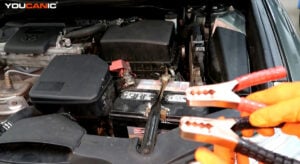Toyota AWD System Malfunction 2WD Mode Engaged
Many Toyota owners are caught in a seemingly never-ending tug-of-war fight against that AWD system malfunction 2WD mode engaged message. Sometimes, that error message will present on the dash while driving on the highway or immediately after starting your vehicle. However, the warning light seldom triggers other running or performance issues in both instances. In this guide, we will go through the common problems we have fixed on a few Toyotas that have had the AWD malfunction and list the most common issues triggering this warning.
The difference between Toyota’s all-wheel-drive system and the 4×4 4-wheel drive used in many other vehicles is that Toyota AWD engages itself when it thinks it’s necessary. The computer monitors every wheel’s speed and the driver’s throttle inputs. When it decides you need extra traction, that’s what you get. The downside is that Toyota AWD errors on the dashboard can be impossible or very difficult to troubleshoot without a diagnostic scanner that reads Toyota fault codes.
What does AWD system malfunction mean on a Toyota?
An AWD system malfunction—2WD mode engaged warning message means your all-wheel-drive Toyota has an issue that deactivated its all-wheel-drive system. It could be an engine problem, which itself could be related to something as simple as a loose gas cap. Other possible culprits include a weak battery or faulty transmission range sensor. We recently diagnosed a car where the AWD system was deactivating if it overheats, which could be a sign of too-aggressive driving or high mileage vehicles.
Toyota AWD System Malfunction Common Causes

To help you out with this, we will go through a list of the most common problems and explain each one. We recommend running a full scan on the vehicle using an OBD-II scanner to determine why the malfunction is coming on the instrument cluster.
- Loose gas cap and check engine light – The AWD system in Toyota RAV4 and similar models is designed to shut down automatically when something triggers a check engine light. One of the things that may cause this is a loose gas cap, as this offsets the operation of the EVAP system. In most cases, this will happen after filling up with gas and driving for several miles, as this is how long the system needs to detect a leak. Tightening the gas cap or replacing it if it’s damaged will solve the problem.
- Battery issues – A worn battery will cause various systems to malfunction, with the all-wheel-drive being one of them. In most cases, this happens after the battery goes flat and the driver jump-starts the vehicle. However, this issue may appear with weak batteries, too, if the voltage drops low enough while cranking. If you have doubts, the best thing to do is to measure the voltage between battery terminals using a multimeter tool.
- Faulty transmission range sensor—Like most other cars, Toyota uses a transmission range sensor to determine which gear the driver has selected. Over time, these sensors wear out internally, causing the signal they send to become interrupted or incorrect. This results in shift issues or refusal to engage the selected gear. In Toyota RAV4 and other all-wheel-drive models, this issue will also trigger the AWD malfunction error. When that happens, the driver is usually unable to start the car.
- Overheating all-wheel-drive system—If the Toyota AWD system overheats while driving, it will automatically shut down to prevent further damage. One cause may be low fluid levels inside the transmission in transfer cases. This is why checking and flushing them regularly per the manufacturers’ recommendations is essential. Another thing that can cause the all-wheel-drive system to overheat is driving style. Its components have limitations, meaning these vehicles usually can’t cope with extreme terrains.
- ABS Wheel Speed Sensors—The Toyota all-wheel-drive system needs to know how fast each wheel is spinning and when to engage which mode. It uses signals from vehicle speed sensors, also used by ABS and VSC safety features. If any of the four sensors fail or get damaged, all these systems, including the AWD, will malfunction.
- Fuel Pump—A large-scale recall in 2020 affected Most all-wheel-drive models made from 2017 onwards, including the popular Toyota RAV4. The issue was caused by a faulty fuel pump, which could deliver less gasoline than needed or fail. Although not directly linked to the AWD system, this problem will cause various engine issues. The AWD system will also shut down if it triggers the check engine light.
- Wiring and fuses—The all-wheel-drive system has several wirings, which can be damaged mechanically by corrosion or rodents. This causes electrical shorts and various other issues, resulting in system malfunction. In addition, damaged wiring will cause corresponding fuses to blow out.
How to diagnose Toyota AWD malfunction
Use a diagnostic scanner to run a full system scan on your Toyota and find out what fault codes are present. The all-wheel-drive malfunction may be caused by something as simple as a loose gas cap or dead battery, transmission range sensor, etc. The transmission range sensor is not too difficult to diagnose or replace.

But even after dealing with the suspected cause, the annoying malfunction message may still be on. This is because, in most cases, the system needs to be reset afterward. To do this, use the YOUCANIC scanner to clear the fault codes.
Frequently Asked Questions
Which Toyota vehicles have the AWD system
The all-wheel-drive system is used in most smaller SUVs, including Toyota RAV4, and some sedans and minivans. It automatically distributes the power between the front and rear axle to achieve the best possible grip without any intervention from the driver. This differs from traditional 4×4 systems fitted in trucks, where drivers select the drive mode by themselves.
Can I drive my Toyota with a malfunctioning AWD system?
Most of the time, your Toyota sends all the power to its front wheels. But when the road gets slippery, the all-wheel-drive kicks in. When this system experiences issues, it automatically shifts into a 2WD mode to prevent damage. Assuming no unusual noises or vibrations are present, you can still drive your Toyota in this mode. Still, the available grip in such conditions may be limited, so adjust your driving style.









